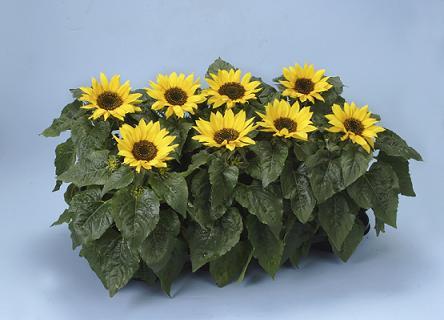

Helianthus pacino dwarf cola
A dwarf sunflower made to brighten up any display. Cute little plants with cute little flowers. Bright golden petals contrast beautifully with the dark centre.
Pacino Cola is a variety of Sunflower which is a member of the Asteraceae family. Its botanical name is Helianthus 'Pacino Cola'. Pacino Cola grows as an Annual and is a flower. Being an Annual, it tends to grow best over the course of a single year. Pacino Cola is known for growing to a height of approximately 1.50 metres (4.88 feet).
Pacino Cola Sunflower is normally quite a low maintenance plant and is normally very easy to grow - great for beginner gardeners!
Plant in a location that enjoys full sun and remember to water often. Pacino Cola is generally regarded as a half hardy plant, so remember to protect this plant from frosts and low temperatures. The USDA Hardiness Zones typically associated with Pacino Cola are Zone 4 and Zone 9. Pacino Cola needs a soil ph of 5.7 to 8.1 (weakly acidic soil - weakly alkaline soil).
Propagation and Growing Method
Propagate from seed in early spring. Sow the seed onto free draining, well aerated media. Leave uncovered as seed need light to germinate. Ideal temperature for germination is 15 - 20 degree Celsius and this will take approximately 5 -10 days. Media should be kept evenly damp but care must be taken so as not to leave it over wet.
Once germination has accrued and first true leaves have emerged, seedlings need to be pricked out and potted on smaller tubes such as 5cm. As soon as the seedlings are large enough to handle they should be spaced further apart or put into individual pots to allow for maximum growth. This has to be done as soon as first seedlings leaves are fully developed and before the next few leaves form. Helianthus is a fast growing plant and the seedlings so I directly transferred to Rx 90 pot.
Usually lift seedlings by holding the plant by one seed leaf, not by the stem. The stem is easily crushed. Overfill the pot / tube then bang it on the bench so that the level drops. Firm mix lightly so that the level is just below the top of the tube. Remove seedlings gently, lift plant by one seed leaf while prising loose the root system with a dibber at the same time. Seedling should come free with the root system intact. Make a hole with the dibber in the medium, large enough for the root system to be placed in without being bent upwards. Gently firm the mix around the seedling. Plant must be well watered as soon as possible after pricking out or potting on.
A free draining peat / bark based potting media is ideal for pH around 6 - 8 and moderate nutrients levels.
The Polytechnic Nursery's standard short term potting mix (1/4 Metre) - {75g Hydraflo II, 875 Osmcote, 750g dolomite & 250g Lime} should be sufficient for this purposes. Helianthus is not heavy feeder and should manage and fine to add extra nutrients.
The plant grows should need to be monitored for mildew, spacing should be appropriate to allow adequate air movement around the foliage. Watering must be restricted to the media to keep leaves from being left damped and therefore inviting diseases. Humidity levels are in correct range.
Standard of Final Product
Plants that are experiencing disease or poor growth will have to be culled, therefore an initial sowing of 100 seeds (with 90% germination rate) will ensure that I required numbers. Monitoring plays an important part in pest and diseases control. Early detection means that the growing environment can be adjusted, or that plant can be removed during the pricking over.
Potential Customer
General public, local gardeners, staff, students of Polytechnic.
After Sale Care Advice
Helianthus should be planted in free draining soil, full sun and plant should be 300cm apart. Dig holes or beds wide, not deep. Lightly amend heavy clay or sandy soils with organic matter and gently remove plants from containers, keeping root ball intact. Loosen potting soil and roots around bottom and edges of root ball. Plant level with surroundings soil, spreading roots outward and fill around roots with lightly amended native soil. Water to settle around roots. Cover the area with leaf or back mulch 1 - 3 inches but not piled up onto the plants stem / trunk. Water deeply to establish.
Excellent work Puvan, very well done! Your diary is now totally optional.
ReplyDelete